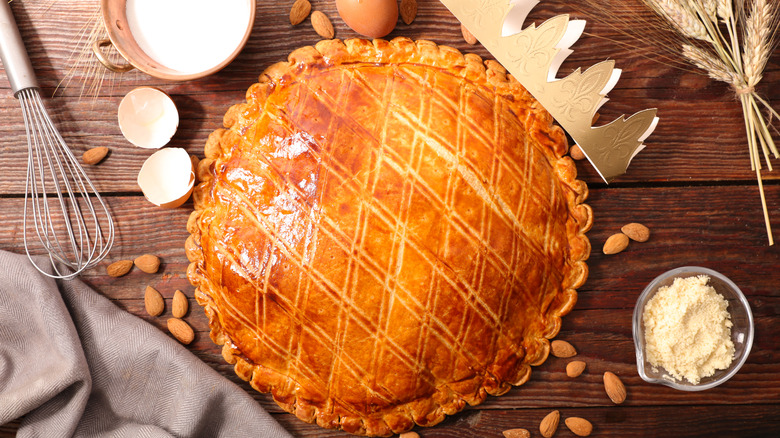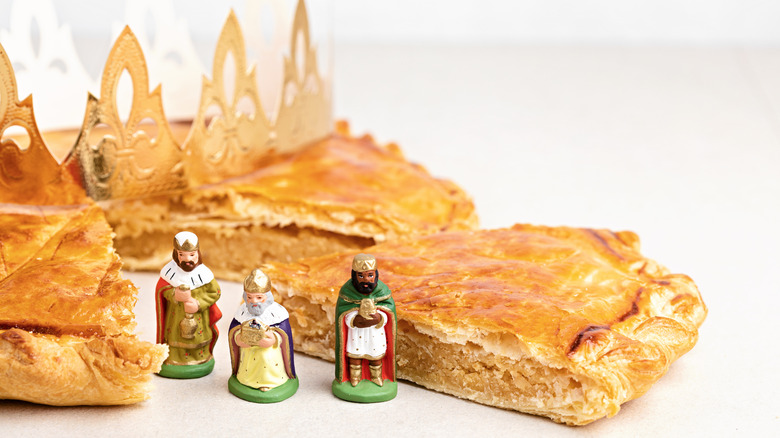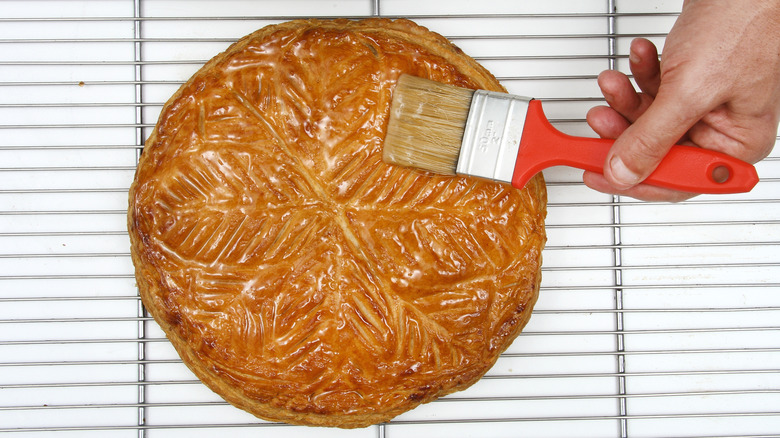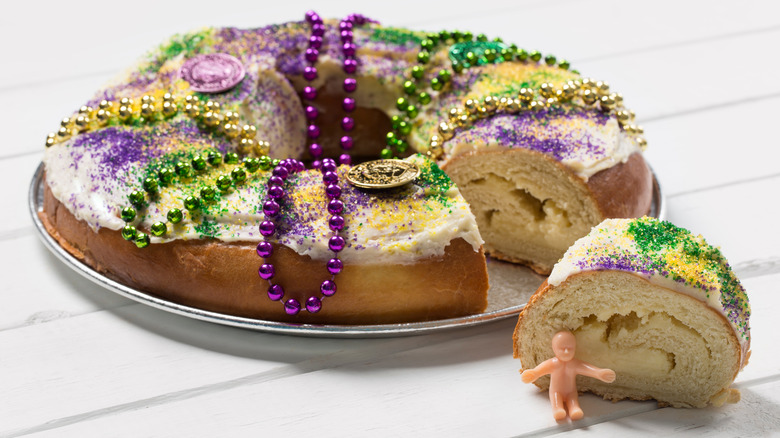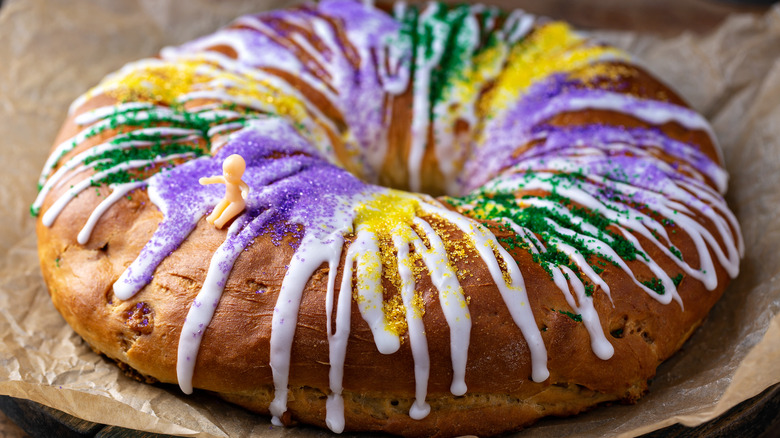What Makes Galette Des Rois Different From King Cake?
King cake looks different in every part of the world, although when most think of "king cake" in English, they're referring to the one from the United States (from New Orleans, to be exact). But there's the Rosca de Reyes of Spain, Dreikönigskuchen in Germany, and galette des rois in France, per Many Eats.
The confusion between the American king cake and the French galette des rois can be attributed to New Orleans' French history. French galette des rois does translate to king (flat) cake and may have been the inspiration for American king cake, but it's only one version of the celebratory pastry (via Gourmandise). Truth be told, these two cakes could not be more different from one another; in fact, the only resemblance they share is the tiny hidden charm found inside each cake.
In a way, both galette des rois and New Orleans king cake are hardly cakes at all in the traditional sense. The French galette des rois looks more like a tart (like most galettes or crostatas) while king cake is a braided bread. Despite their differences, both likely originate from the same Roman holiday — yes, Roman, not Catholic.
History of galette des rois
Every January 6th, which is the Twelfth Night following Christmas, Catholics celebrate Epiphany. This Christian holiday correlates to the day the three wise men, hailing from different continents, visited Jesus, according to the Consulate General of France in Toronto. Galette des rois is eaten on this day to celebrate the Epiphany, but before it was used in this Christian celebration, it originated from a pagan Roman holiday in honor of Saturn for the winter solstice (known as Saturnalia), per Corman. Key components of this original galette remain in galette des rois today; in fact, Romans placed a fève, usually a bean, into the cake so that the person (usually a slave) who found it would be king of the day, hence the cake's name.
Once galette des rois became a more Christianized cake, the fève bean was replaced with a porcelain baby figurine to represent the infant Christ. The Consulate General of France in Toronto states that the cake is supposed to be large enough for big groups to enjoy. It used to be cut into the same number of pieces as there were guests — with one extra added. Apparently, the least fortunate guest to join in on festivities would get this extra slice, and if luck were on their side, they would find a fève inside. The galette's beautiful embellishments make an otherwise plain tart more suitable for festive occasions.
How to make galette des rois
Like all tarts, much of the effort that comes with putting galette des rois together is making the intricate puff pastry crust. If you decide to make your own puff pastry, you must pay close attention to the elasticity of your dough, the temperature of your butter, and the precision of your folds. To skip the arduous lamination process, you can simply buy a good-quality puff pastry from the store.
Now comes the fun part: Picking your fève, which can be a bean, a porcelain bean, a plastic baby, or anything of that nature.
The filling of a galette des rois is less complicated than you'd think: A simple frangipane is all it takes to finish the inside, with the much-desired fève hiding somewhere in the cream. A frangipane is a traditional pastry filling made of almond flour, eggs, sugar, butter, and a bit of flour, not to be confused with another almond paste called marzipan.
What separates a galette des rois from any frangipane-filled pie is the intricate knifework on the top, which makes an otherwise ordinary pie look royal. Whether you want to do a classic spiral pattern or some woven hatchwork depends on your own taste, but you should always be sure to glaze the top with egg wash for a golden finish.
History of king cake
Of course, we cannot discuss king cake without linking it to the French king cake, galette des rois. Still, king cake in the States is closer to king cake from Spanish-speaking countries such as Rosca de Reyes or bolo rei, according to Eater. We can also find some similarities in the New Orleans king cake to the lesser-known galette des rois from southern France, which is also a brioche cake. Across the board, all king cakes originate from the celebration of the pagan holiday and subsequently contain little fèves inside to determine the king of the day.
King cake in New Orleans is most often enjoyed on Mardi Gras, also known as "Fat Tuesday," which is the day before Ash Wednesday (via Britannica). Mardi Gras is sometimes a week-long celebration where people enjoy the fatty foods, alcohol, and meats that they plan to swear off during Lent. Although Mardi Gras celebrations usually land over a month after Epiphany, king cakes start showing up in bakeries from Epiphany right up until Fat Tuesday comes around.
How to make king cake
King cake from New Orleans is a sweet brioche cake shaped like a huge ring, adorned with sprinkles in the classic Mardi Gras trio of colors: Purple, green, and gold. The brioche itself can be filled with cinnamon, cream cheese, or chocolate, but the options are endless, per Southern Living.
Despite its humble appearance, king cake is more involved than a galette des rois due to the brioche component. Making a good brioche requires a lot of elbow grease, wait time for proofing, and skill in braiding. Like any yeasted dough, it starts off with warmed milk and butter, which are incorporated with eggs and bread flour.
Once the dough ball is formed, you let it rise while you make the filling of your choice. Our banana fosters king cake is almost like an uncut cinnamon roll log, with cream cheese and caramelized bananas interspersed between the dough. The fève can go in during the rolling process so that it lies hidden in the brioche. Once you bring the ends of the roll together to form a large ring shape, you bake your brioche and glaze it so that the celebratory sanding sugars can stick to the cake.
